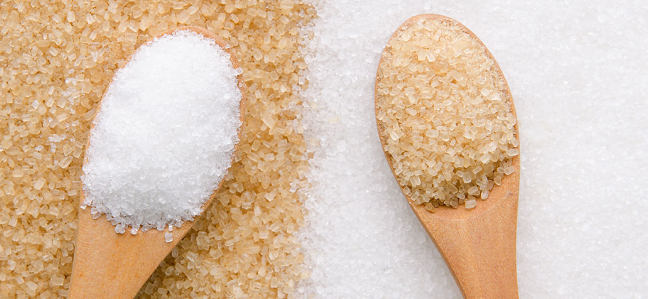
When you add sweetness to your morning cup of coffee, most likely you choose white, granulated sugar. You could also use sugar in the raw or brown sugar, both products of sugar cane purification.
Raw Sugar
When sugar cane arrives from the fields, sugar millers grind and press it to extract the sweet juices. Crystals that form in the liquid are granules called raw sugar. After going through filtration and hot water washes, the sugar contains 96 percent sucrose and 4 percent of plant materials contained in the mother liquid. Vacuum-drying this product leaves a golden brown color and sweet taste but very little nutritional value, except for calories from the carbohydrate content. The raw sugar can either go to the consumer or to the refinery for further processing.
Molasses
After filtering out plant trash and raw sugar crystals, millers slowly evaporate the liquid, resulting in a rich, brown mixture called molasses. Molasses contains 46 percent dissolved sucrose and other sugars; 3 percent protein; small amounts of minerals like calcium, phosphorous, magnesium and sulfur; trace elements such as copper, iron, manganese and zinc; and B-vitamins. Molasses is used for both human and animal consumption. Producers may also mix it with raw sugar to facilitate transport to a refinery, or with white sugar to yield brown sugar.
White Sugar
At the refinery, the raw sugar and molasses mixture undergoes further washing with hot water and separation through centrifugation and filtration. The naturally white crystals that remain are 99.9 percent sucrose. This sugar can go to grinding machines that produce different sizes of granules -- everything from crystals to powders -- for use in household and commercial cooking and flavoring.
Brown Sugar
Mixing white sugar crystals with various amounts of molasses results in a soft, lumpy product called brown sugar. The amount of molasses added depends on the producer, but you could expect light brown sugar to contain 3.5 percent molasses, while dark brown sugar might contain 6.5 percent molasses.Brown sugar imparts the taste of molasses to recipes and adds moisture to make a softer texture.
Considerations
Raw sugar differs very little from white sugar, except that the crystals of raw sugar are larger and have more color. In spite of trace amounts of minerals in molasses, brown sugar contains only slightly more nutritive value than raw sugar because the amounts added back are so small. The calories of raw sugar and brown sugar are the same. Both raw sugar and brown sugar appeal to people and animals because of the sweet taste and burst of caloric energy.
Your Health Is Our Concern!
Mawuena Workartey/ Ghanahospitals.org